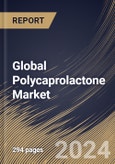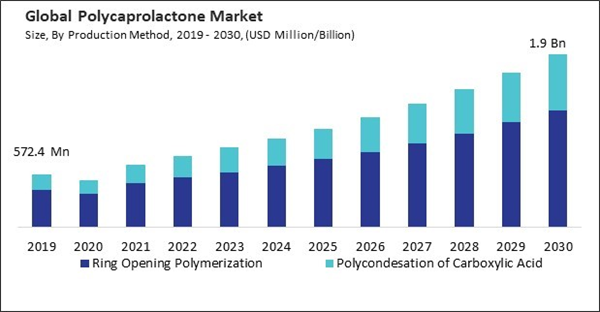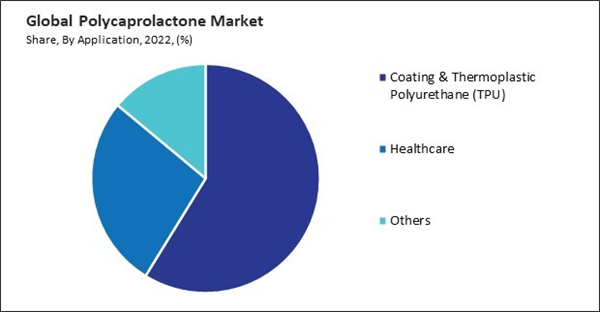The Global Polycaprolactone Market size is expected to reach $1.9 billion by 2030, rising at a market growth of 11.7% CAGR during the forecast period. In the year 2022, the market attained a volume of 888.5 Hundred Tonnes, experiencing a growth of 10.9% (2019-2022).
Projects involving the Asia Pacific region’s building, transportation, and urbanization necessitate using materials with particular qualities, such as resilience to weather, flexibility, and durability. Therefore, the Asia Pacific segment captured $311.9 million revenue in the market in 2022. PCL-based materials can meet these requirements, increasing demand for PCL in construction, coatings, and infrastructure applications.
Increasing awareness of environmental issues, such as plastic pollution and the accumulation of non-biodegradable waste in landfills and oceans, has led to a shift towards sustainable alternatives. PCL, in particular, offers desirable properties such as biocompatibility, thermal stability, and flexibility, making it suitable for various applications across industries. Hence, the rising adoption of biodegradable materials propels the market’s growth.
Additionally, Selective laser sintering (SLS) and fused deposition modeling (FDM) are two 3D printing processes that are extremely compatible with PCL. The 3D printing industry in Italy has been growing at a steady rate of about 20% for the last decade or so and is set to continue. Also, as per the same source, the value of Australia’s total additive manufacturing/3D Printing industry is estimated at USD70 million. Hence, the expansion of the global 3D printing industry is driving the growth of the market.
However, raw materials used in the production of PCL may also be utilized by other industries, such as the food, pharmaceutical, and cosmetics sectors. Seasonal factors such as crop harvesting periods, weather conditions, and agricultural practices can impact the availability and quality of raw materials, affecting production schedules and inventory management for PCL manufacturers. Hence, the limited availability of raw materials is hampering the market’s growth.
Projects involving the Asia Pacific region’s building, transportation, and urbanization necessitate using materials with particular qualities, such as resilience to weather, flexibility, and durability. Therefore, the Asia Pacific segment captured $311.9 million revenue in the market in 2022. PCL-based materials can meet these requirements, increasing demand for PCL in construction, coatings, and infrastructure applications.
Increasing awareness of environmental issues, such as plastic pollution and the accumulation of non-biodegradable waste in landfills and oceans, has led to a shift towards sustainable alternatives. PCL, in particular, offers desirable properties such as biocompatibility, thermal stability, and flexibility, making it suitable for various applications across industries. Hence, the rising adoption of biodegradable materials propels the market’s growth.
Additionally, Selective laser sintering (SLS) and fused deposition modeling (FDM) are two 3D printing processes that are extremely compatible with PCL. The 3D printing industry in Italy has been growing at a steady rate of about 20% for the last decade or so and is set to continue. Also, as per the same source, the value of Australia’s total additive manufacturing/3D Printing industry is estimated at USD70 million. Hence, the expansion of the global 3D printing industry is driving the growth of the market.
However, raw materials used in the production of PCL may also be utilized by other industries, such as the food, pharmaceutical, and cosmetics sectors. Seasonal factors such as crop harvesting periods, weather conditions, and agricultural practices can impact the availability and quality of raw materials, affecting production schedules and inventory management for PCL manufacturers. Hence, the limited availability of raw materials is hampering the market’s growth.
By Form Analysis
Based on form, the market is divided into pellets, nanosphere, and microsphere. The nanosphere segment attained a 28.21% revenue share in the market in 2022. PCL nanospheres are widely used in drug delivery applications due to their ability to encapsulate and release drugs in a controlled manner. These spheres are nanoscale in size, which allows for targeted drug delivery to certain tissues or cells, reducing systemic side effects and enhancing therapeutic efficacy.By Application Analysis
Based on application, the market is categorized into coating & thermoplastic polyurethane (TPU), healthcare, and others. In 2022, the coating & thermoplastic polyurethane (TPU) segment registered 61.15% revenue share in the market. PCL exhibits excellent flexibility and elasticity, which is desirable for coatings and thermoplastic polyurethane applications.By Production Method Analysis
On the basis of production method, the market is segmented into ring opening polymerization and polycondensation of carboxylic acid. The ring opening polymerization segment recorded 72.53% revenue share in the market in 2022. Ring-opening polymerization (ROP) offers a controlled method for synthesizing PCL with desirable molecular weights and properties. This controlled process allows for the production of PCL with consistent characteristics, which is important for various applications.By Regional Analysis
Region-wise, the market is analyzed across North America, Europe, Asia Pacific, and LAMEA. In 2022, the North America region generated a 23.06% revenue share in the market. North America has a strong biomedical and healthcare sector that demands biodegradable and biocompatible materials like PCL. Additionally, PCL is used in various medical applications such as tissue engineering, drug delivery systems, wound dressings, surgical sutures, and implants.List of Key Companies Profiled
- Corbion N.V.
- Otto Chemie Pvt. Ltd.
- BASF SE
- Perstorp Holding AB (PETRONAS Chemicals Group Berhad)
- Daicel Corporation
- Haihang Industry Co.,Ltd. (Haihang Group)
- Merck KGaA
- Polysciences, Inc.
- Shenzhen Esun Industrial Co., Ltd.
- Shenzhen Polymtek Biomaterial Co., Ltd.
Market Report Segmentation
By Production Method (Volume, Thousand Tonnes, USD Billion, 2019-2030)- Ring Opening Polymerization
- Polycondesation of Carboxylic Acid
- Pellets
- Nanosphere
- Microsphere
- Coating & Thermoplastic Polyurethane (TPU)
- Healthcare
- Others
- North America
- US
- Canada
- Mexico
- Rest of North America
- Europe
- Germany
- UK
- France
- Russia
- Spain
- Italy
- Rest of Europe
- Asia Pacific
- China
- Japan
- India
- South Korea
- Singapore
- Malaysia
- Rest of Asia Pacific
- LAMEA
- Brazil
- Argentina
- UAE
- Saudi Arabia
- South Africa
- Nigeria
- Rest of LAMEA
Table of Contents
Chapter 1. Market Scope & Methodology
Chapter 2. Market at a Glance
Chapter 3. Market Overview
Chapter 4. Global Polycaprolactone Market by Production Method
Chapter 5. Global Polycaprolactone Market by Form
Chapter 6. Global Polycaprolactone Market by Application
Chapter 7. Global Polycaprolactone Market by Region
Chapter 8. Company Profiles
Companies Mentioned
- Corbion N.V.
- Otto Chemie Pvt. Ltd.
- BASF SE
- Perstorp Holding AB (PETRONAS Chemicals Group Berhad)
- Daicel Corporation
- Haihang Industry Co.,Ltd. (Haihang Group)
- Merck KGaA
- Polysciences, Inc.
- Shenzhen Esun Industrial Co., Ltd.
- Shenzhen Polymtek Biomaterial Co., Ltd.
Methodology

LOADING...










